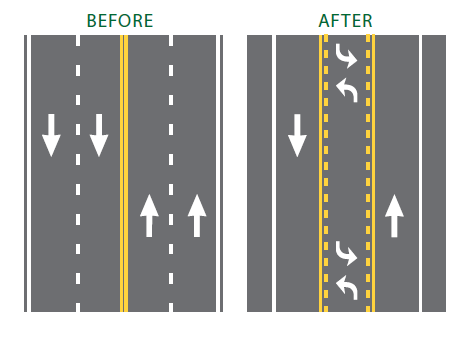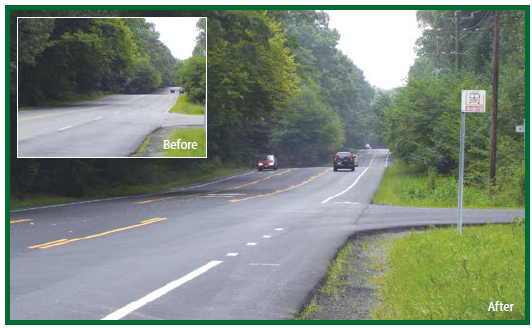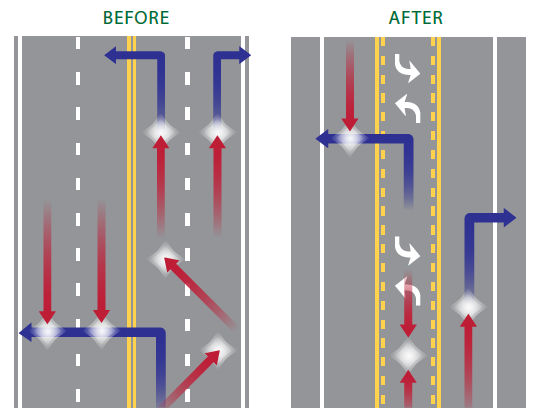U.S. Department of Transportation
Federal Highway Administration
1200 New Jersey Avenue, SE
Washington, DC 20590
202-366-4000
Download Printable Version:
[PDF, 425 KB]
A typical Road Diet converts an existing four–lane undivided roadway segment to a three–lane segment consisting of two through lanes and a center two–way left–turn lane (TWLTL). This reduction of lanes allows for other uses such as bike lanes, pedestrian refuge islands, transit stops, or parking. A Road Diet can reduce crash rates compared to a traditional four–lane undivided roadway.

A Road Diet can be a low–cost safety solution, particularly in cases where only pavement marking modifications are required to make the traffic control change. In other cases, the Road Diet may be planned in conjunction with reconstruction or overlay projects, and the change in cross section allocation can be incorporated at little or no additional cost.
Road Diets provide benefits to users of all modes of transportation, including bicyclists, pedestrians, and motorists. Benefits can include the following:

Lawyers Road, before and after a 2009 Road Diet
Source: Randy Dittberner, Virginia DOT
Reston, Virginia, a suburb of Washington, DC, is a planned community with a larger emphasis on non–motorized travel than many suburbs. The need for multi–modal accessibility has increased with the opening of a nearby rail transit station.
The Virginia Department of Transportation (VDOT) implemented a Road Diet on a 2–mile segment of Lawyers Road in Reston in conjunction with a repaving project in 2009. Although community reaction was mixed before the project, views shifted to strong support after implementation. In addition to the clear benefits of dedicated bicycle infrastructure and left–turn space, the project helped reduce crashes in the corridor by nearly 70%. Community support was so strong that a second Road Diet was installed on nearby Soapstone Drive in 2011, and Soapstone has also achieved a 70% crash reduction. The resulting linked network of bicycle accommodations provides an excellent travel option for access to the transit station. The success of the Reston projects is leading VDOT to expand its use of Road Diets regionwide.
Four–lane undivided highways have a history of relatively high crash rates, especially as traffic volumes and turning movements increase. The main issue is that the left (inside) lane is shared by higher–speed through traffic and left–turning vehicles. Road Diets reduce the number of vehicle–to–vehicle conflict points that contribute to rear–end, left–turn, and sideswipe crashes.
Studies indicate a 19 to 47 percent reduction in overall crashes when a Road Diet is installed on a previously four–lane undivided facility as well as a decrease in crashes involving drivers under 35 years of age and over 65.1, 2

Road Diet Informational Guide
FHWA–SA–14–028
http://safety.fhwa.dot.gov/
Proven Safety Countermeasure
Road Diet Fact Sheet
FHWA–SA–12–013
http://safety.fhwa.dot.gov/provencountermeasures/fhwa_sa_12_013.htm
Rebecca Crowe
FHWA Office of Safety
rebecca.crowe@dot.gov
(202) 507-3699
Visit www.safety.fhwa.dot.gov to learn more about Road Diets.
1 FHWA "Evaluation of Lane Reduction 'Road Diet' Measures on Crashes." FHWA Report No. FHWA–HRT–10–053. (Washington, D.C: 2010)
2 Stout, Thomas B., Before and After Study of Some Impacts of 4–Lane to 3–Lane Roadway Conversions. March 2005.
